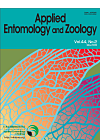39 巻, 4 号
選択された号の論文の23件中1~23を表示しています
- |<
- <
- 1
- >
- >|
Review
-
2004 年 39 巻 4 号 p. 565-573
発行日: 2004年
公開日: 2005/02/25
PDF形式でダウンロード (207K)
Mini Review
-
2004 年 39 巻 4 号 p. 575-581
発行日: 2004年
公開日: 2005/02/25
PDF形式でダウンロード (288K)
Regular Papers
-
2004 年 39 巻 4 号 p. 583-589
発行日: 2004年
公開日: 2005/02/25
PDF形式でダウンロード (443K) -
2004 年 39 巻 4 号 p. 591-596
発行日: 2004年
公開日: 2005/02/25
PDF形式でダウンロード (151K) -
2004 年 39 巻 4 号 p. 597-601
発行日: 2004年
公開日: 2005/02/25
PDF形式でダウンロード (168K) -
2004 年 39 巻 4 号 p. 603-609
発行日: 2004年
公開日: 2005/02/25
PDF形式でダウンロード (393K) -
2004 年 39 巻 4 号 p. 611-616
発行日: 2004年
公開日: 2005/02/25
PDF形式でダウンロード (78K) -
2004 年 39 巻 4 号 p. 617-623
発行日: 2004年
公開日: 2005/02/25
PDF形式でダウンロード (258K) -
2004 年 39 巻 4 号 p. 625-629
発行日: 2004年
公開日: 2005/02/25
PDF形式でダウンロード (472K) -
2004 年 39 巻 4 号 p. 631-634
発行日: 2004年
公開日: 2005/02/25
PDF形式でダウンロード (208K) -
2004 年 39 巻 4 号 p. 635-641
発行日: 2004年
公開日: 2005/02/25
PDF形式でダウンロード (72K) -
2004 年 39 巻 4 号 p. 643-649
発行日: 2004年
公開日: 2005/02/25
PDF形式でダウンロード (148K) -
2004 年 39 巻 4 号 p. 651-659
発行日: 2004年
公開日: 2005/02/25
PDF形式でダウンロード (115K) -
2004 年 39 巻 4 号 p. 661-667
発行日: 2004年
公開日: 2005/02/25
PDF形式でダウンロード (212K) -
2004 年 39 巻 4 号 p. 669-674
発行日: 2004年
公開日: 2005/02/25
PDF形式でダウンロード (567K) -
2004 年 39 巻 4 号 p. 675-682
発行日: 2004年
公開日: 2005/02/25
PDF形式でダウンロード (104K) -
2004 年 39 巻 4 号 p. 683-689
発行日: 2004年
公開日: 2005/02/25
PDF形式でダウンロード (186K) -
2004 年 39 巻 4 号 p. 691-697
発行日: 2004年
公開日: 2005/02/25
PDF形式でダウンロード (175K) -
2004 年 39 巻 4 号 p. 699-704
発行日: 2004年
公開日: 2005/02/25
PDF形式でダウンロード (594K) -
2004 年 39 巻 4 号 p. 705-715
発行日: 2004年
公開日: 2005/02/25
PDF形式でダウンロード (241K) -
2004 年 39 巻 4 号 p. 717-725
発行日: 2004年
公開日: 2005/02/25
PDF形式でダウンロード (115K) -
2004 年 39 巻 4 号 p. 727-730
発行日: 2004年
公開日: 2005/02/25
PDF形式でダウンロード (215K) -
2004 年 39 巻 4 号 p. 731-737
発行日: 2004年
公開日: 2005/02/25
PDF形式でダウンロード (439K)
- |<
- <
- 1
- >
- >|
